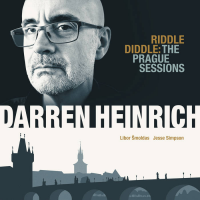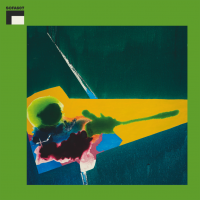Home » Jazz Articles » Extended Analysis » Matt Garrison: Matt Garrison: Shapeshifter
Matt Garrison: Matt Garrison: Shapeshifter
Not merely a great electric bassist, he actually plays the instrument at the margins of human capability. Having captured the imaginations of the world's electric bass players and enthusiasts, he's set his sights on the ears and minds of the global audience for adventurous music. Importantly, he does so without taking virtuoso technique and mind-boggling facility off the table. Compositionally, he's retained the far eastern Indian flavor of his debut, while adding a brave new dose of electronica to the mix. There's a new emphasis on consistently changing up the tone and texture of the bass, in both ensemble and solo functions. The numbers of supporting cast and their roles have been narrowed, with Garrison taking on more of the burden of soundscape creation via computer-aided studio expertise. Finally, he's perfected the art of creating hook- laden melodic snippets, and placing them in various spots in the mix relative to countermelodies, counter-rhythms and counter-bass lines, none of which function counter to any other components.
For example, "Symbiosis," opens the set with a melodic fragment of eastern origin, sung by Sabina Sciubba , meeting percussively strummed acoustic guitar (also by Garrison), before being supplanted by slamming, power-chord style, distorted bass, in an ascending four-part progression of three notes each. A melody line reemerges, this time sung by the bass, chiming, sitar-like, with notes in the high register. A deep bass synth break recontextualizes the opening, vocal melody, as new synth pads offset the complementary descending bass line. Unison guitar and bass then voice a different, equally hummable melodic fragment over a loping folk-fretless line. This sets up a distorted, backward-looped bass solo, gorgeously steeped in expressive psychedelia. As the backward effect is removed, Garrison's trademarked shards, pieces of chords drawn from the scale-of-the-moment's harmony, replace it, followed by effortless linear melodicism, building to a phenomenal ripping sequence of his own device, recalling Jimi more than Jaco.
"Three Tree" is a duet with Arto Tuncboyacian on percussion. Any bassist who throws down this fluidly and virtuosically in the company of a sole percussionist is bound to get comparison to "Donna Lee," Jaco's celebrated throwing of the gauntlet with Don Alias. This one's a bossa improv of epic proportion. It's all there, the gorgeous chord voicings, the harmonic outline, the flat-out speed and impossible articulation of the right hand, the matching up of the left with the complete knowledge and instantaneous availability of the jazz vocabulary. But this is not an instrumentalist playing some famous standard at a breakneck pace. It's a relaxed performance, a spontaneous improvisation that right away imparts the feeling that Garrison could toss off any number of takes on this vibe, each of them as great as the last, yet different -what jazz, and virtuosity, are all about.
"Life Burning" combines the love for all things Indian with all things Squarepusher-drill'n'bass meets drilling bass for some Punjabi takeout. Note the Indian Massive-that's the real , Indian, massive bass sound punctuated by some kind of Hindu chanting -or is that cheerleading? Slamming it all against a very straight snare and hi-hat beat somehow propels it to the energy quotient to the next level, as do the wordless vocals by Tuncboyacian. The electronica sequence returns before another monster solo blows it all up, crossing up "Flight of the Bumblebee" pyrotechnics with ragaisms aided by pull-offs and trills, stopping for a hit of funky blues. The linear excursions that follow are decidedly not of the bop vocabulary; rare is the player on any instrument that draws lines so clearly from harmonic point to point that sit so well on their axe of choice.
"I Can See You Now" slams enormous rock riffing up against Gnawan trance, with ankle-bracelet bells evoking Krishnas brandishing Strats. Big air moves under fretless skies, propelled forward by a Pastourian pump never executed so cleanly. Then screams, samples of massive human call and response added by Scott Kinsey , accelerate us into his scintillating Rhodes solo, which somehow injects a dose of funk into this electro-world groove. Note that Kinsey, perhaps in compensation for his inhuman chops quotient, has now established himself as an innovator for incorporating the human element, in the form of sampled vocals—pitched, unpitched, sung, spoken or screamed—into his custom-programmed sonic voice.
"Mirror Image" and "Changing Paths," both completely performed by Garrison, have a more epic, world flavor. The "Mirror" reflects West Africa or Algiers perhaps, a crossover incorporating incantations on high, with Matt on vocals. Like many cutting-edge instrumentalists, Garrison reveals he's a surprisingly gifted vocalist as well. No solos here, just pure melody and atmospherics combined in heartrending ways. "Changing Paths" shows the influence of Sting or Peter Gabriel in terms of mystically elegant soundscape, a somber frame drum march setting up haunting harmony, this one features his eerie, highly proficient steel-string guitar to supplement his tear-drenched bass sweep, supplemented by a distant scat vocal. More experiments in this direction, please.
"Exchange" builds fiercely in electronic fashion but soon adds beauty in the form of Icelandic vocalizing by Veronika Garrison over two-note chords voicing the melody on bass. A passage then ensues full of wondrous digitized glossolalia, a combination of backward bass triggering Veronika's sampled vocal, creating the effect of a sci-fi enchantress enticing explorers toward her embrace, abetted by some kind of otherworldly sound-producing device. As Kinsey enters the fray the song delves into the realm of Josef Zawinul, employing the familiar accordion and harmonica-like sounds, an ethnic, folk-like wordless vocal and a bouncy, rubbery bass line. Kinsey has seriously studied Zawinul's improvisational and compositional styles, as well as the finer elements of his sound architecture, and Garrison is a former employee, so this section is all you can imagine. The bass solo begins gently, drenched in linear lyricism, with a touch of distortion, interrupted by electronic stutters and stops. A simple backbeat is employed to support complexity as the digital stuttering effect continues, punctuating and puncturing the solo, a multitude of ideas and techniques colliding to create an ultra-modern, yet very musical spot. This type of diginoise effect is usually applied to breakbeats or other sections in the work of noted digital auteurs, but this sets the precedent for seamless incorporation into an instrumental solo, which helps makes "Exchange" another compositional and soloing tour-de-force.
"Turn Around," concludes with layer upon layer: Garrison's bass, Jim Beard 's synth, and Adam Rogers ' banjo and cavaquino, until a melody line is doubled on top by the vocals of Matt's singer-sister Joy and the harmonica of Gregoire Maret. Two minutes in, this shimmering cloud rains a liquid bass solo, a "rewind moment " that in 45 seconds, simply transcends the work of the generation of bassists that made Garrison possible-not only in the harmonic sense, standing as a mini-composition, but in that it exudes electrifying emotion, molten with the passion and joy radiating from its architect. Rogers, with clean electric tone and Beard, employing synth-sustained squeezebox, follow with equally prodigiously executed spots bursting with poignant content-rare does this muscular an instrumental display, by all the players, convey such ecstatic exhilaration.
This release represents a modern-day passing of the torch. Compelling that Garrison's father played acoustic bass on what are indisputably jazz's greatest recordings -now comes Matthew demonstrating nothing less than he's the world's greatest electric bass guitarist (reality check: if there are other guys capable of playing this stuff so absolutely freakishly, none are demonstrating it on recordings). The funny thing is, this is way not the intent here.
Sure, Garrison's debut, in spots, was attempting to show all he could do, but now it's all about the composition, the composite, the trip and the vibe. The fact that he's taken the record label out of the equation has surely aided him in feeling his way into his style in the most comfortable, organic way. Simply put, letting go has allowed him to craft one for the ages. It's a benchmark for the type of electronica that is separate from trend-jumping jazztronica hybrids and for music incorporating world influences that is separate from the "world music" bin. Most importantly, it should be held up as a shining example for the type of electric jazz-fusion of musics and styles that is separate from the technocratic, chops-driven excesses and exercises of "fusion" 's past.
Recently, vocal jazz has been perceived to have returned to favor with artists like Norah and Jamie, the piano trio reworked by the Bad Plus and EST and the avant-garde invigorated by the talent stable locked in the Blue Series' electronica laboratory. But in terms of marketability, resonance and relevance, electric jazz remains at a crisis point— in need of a shot in the arm—a reinvention triggering a comeback of sorts. With a release of this magnitude, it's alluring to poetically posit that Garrison, a scion of jazz's fabled past, yet an outsider in the current state of the jazz business, should be the one fated to spearhead that transformation.
Track Listing
1) Symbiosis, 2) Unity, 3) I Told Ya So, 4) Three Tree, 5) I Can See You Now, 6) ZZAJ 5.1, 7) Life Burning, 8) Mirror Image, 9) Exchange, 10) Changing Paths, 11)Turn Around.
Personnel
Matt Garrison
saxophoneSabina Sciubba:vocals (1,2,3), Gregoire Maret:harmonica (1,2,11), Arto Tuncboyacian:percussion (1,2,4,7, 9), vocals (7), Jim Beard: keyboards (1,2,11), Jojo Mayer: drums (2,7), Elliot Mason: bass trumpet (5), Scott Kinsey: keyboards (5,9), Will Calhoun: Wusuli (5), Veronika Garrison: vocals (7,9), noise (5), Joy Garrison: vocals (11), Adam Rogers, guitar (11), Warren Brown:mixing, mastering, sound design (all), John Arnold: drums (11), Matthew Garrison: bass (all), programming (1-3, 5-11), guitar (1,3,10), keyboards (2,3,7,9,11), vocals (5,9,10,11)
Album information
Title: Shapeshifter | Year Released: 2004 | Record Label: Self Produced
Tags
PREVIOUS / NEXT
Support All About Jazz
 All About Jazz has been a pillar of jazz since 1995, championing it as an art form and, more importantly, supporting the musicians who make it. Our enduring commitment has made "AAJ" one of the most culturally important websites of its kind, read by hundreds of thousands of fans, musicians and industry figures every month.
All About Jazz has been a pillar of jazz since 1995, championing it as an art form and, more importantly, supporting the musicians who make it. Our enduring commitment has made "AAJ" one of the most culturally important websites of its kind, read by hundreds of thousands of fans, musicians and industry figures every month.




















